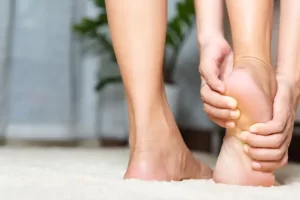Aches and pains can come from all sorts of things: how you move, your body structure, and even your genes. Pinpointing the exact reason for discomfort can be a puzzle. Enter sciatic nerve pain, aka sciatica. When diagnosed correctly, it’s like a roadmap pointing to the real issue causing your pain. That means there’s hope for relief, and fast. Dr. Eli Loch, D.O., at Ponte Vedra Spine & Pain Center, gets how frustrating sciatica can be. He’s on a mission to help you find sciatica pain relief by understanding the symptoms and causes of sciatica through smart diagnosis and the latest treatments.
What is Sciatica and What are the Symptoms?
The sciatic nerve, the body’s longest nerve, begins in your lower back and travels through your buttocks and down into your leg. Sciatica is a painful condition that can occur as a result of injury, irritation, or impingement of this large nerve. Sciatica is a very common condition. About 40% of people in the U.S. experience some form of sciatica during their lifetime. It rarely happens before age 20 unless it’s injury-related. When it comes from individual nerve roots in the lower back, it is also referred to as lumbar radiculopathy.
Sciatic pain varies, often feeling like a shooting pain in your lower back, down your legs, or in your buttocks. It might also come with numbness, tingling, or a strange loss of feeling in your lower legs and feet.
While the pain associated with sciatica differs from person to person, most cases respond well to treatment within a few weeks. If symptoms persist for eight weeks or less, it’s labeled acute sciatica; if they persist for more than approximately eight weeks, it’s termed chronic sciatica.
When you’re dealing with sciatica symptoms, obtaining an accurate diagnosis is crucial. This ensures an understanding of the specific cause of your symptoms rather than assuming it’s the typical sciatica linked with back pain. Identifying the true source of the pain is key to receiving the appropriate treatment for sciatica pain relief, helping you return to a full and active life in Ponte Vedra, FL.
What Exactly Causes Sciatica?
Sciatica can happen for different reasons, all linked to pressure on the sciatic nerve, which many people describe as a pinched nerve in the lower back. Imagine your spine like a stack of building blocks, each block being a vertebra, and in between them are cushion-like discs made of cartilage. These discs play bodyguard, protecting the vertebrae and surrounding structures. If one of these discs decides to shift out of place and end up pushing on the sciatic nerve, sciatica kicks in. With that being said, sciatica isn’t just a random pain; it’s often a result of this nerve getting a bit too much pressure. Understanding this helps shed light on what might be causing your sciatica and how to tackle it. Common causes of sciatica include:
- Herniated discs: A common culprit behind sciatica, herniated discs, which occur when the gel-like material within the spinal disc leaks out, pressing on the nearby sciatic nerve.
- Degenerative disk disease: As we age, the spinal discs can wear down, losing their cushioning effect. This degeneration can lead to sciatica by allowing more direct contact and pressure on the sciatic nerve.
- Spinal stenosis: This condition involves the narrowing of the spinal canal, putting pressure on the spinal cord and nerves, including the sciatic nerve, often causing pain and discomfort.
- Foraminal stenosis: Similar to spinal stenosis, foraminal stenosis specifically involves the narrowing of the foramen, the openings through which spinal nerves exit the spinal column, leading to sciatic nerve compression.
- Spondylolisthesis: Occurring when one vertebra slips forward over another, spondylolisthesis can result in the compression of the sciatic nerve due to the misalignment of the spine.
- Osteoarthritis: In cases where the protective cartilage on the ends of bones wears down over time, osteoarthritis can lead to the development of bone spurs and inflammation, potentially affecting the sciatic nerve.
- Injuries: Traumatic events, such as falls or accidents, can cause injuries to the spine, resulting in sciatica. Fractures, dislocations, or soft tissue damage can contribute to nerve compression.
- Tumors, cysts, or other growths: Abnormal growths within the spinal canal can exert pressure on the sciatic nerve, causing sciatica. Tumors, cysts, or other masses may interfere with the nerve’s normal function.
- Pregnancy: While pregnancy itself doesn’t directly cause sciatica, some women may encounter sciatic pain during this period. This can be attributed to several factors, including:
- Weight gain and fluid retention
- Shifting center of gravity
- Uterine expansion
- Baby’s resting position
As we continue to explore sciatica, it’s clear it’s more than just physical discomfort; it reflects the delicate balance within our bodies. Whether it’s common issues like herniated discs or more complex conditions like spondylolisthesis, we’re here for you at Ponte Vedra Spine & Pain Center. Your well-being is our priority, and together, we will navigate the path toward sciatica pain relief!
How is Sciatica Diagnosed and Treated at Ponte Vedra Spine & Pain?
Following a thorough discussion of your medical history and symptoms, Dr. Eli Loch, D.O., will conduct a comprehensive physical examination. This includes assessing your reflexes and muscle strength. You might be asked to perform some basic physical tasks during this examination. Additionally, obtaining an X-ray, MRI, or other imaging exams may be recommended to pinpoint the source of your pain. These diagnostic tests not only aid in identifying the specific cause of sciatica but also play a crucial role in ruling out other conditions that may mimic similar symptoms.
Treating sciatica usually involves trying to decrease pain and increase mobility. Many treatments are things you can do yourself. There are several treatment options if you have sciatica that won’t go away or is more severe. Surgery might be an option if your case is severe or other treatments don’t help. Common types of treatment for sciatica pain relief at Ponte Vedra Spine & Pain Center in Ponte Vedra, FL include:
Nonsurgical treatments:
- Applying cold packs or heat
- Taking over-the-counter medications such as NSAIDs (nonsteroidal anti-inflammatory drugs) like ibuprofen or naproxen
- Medications specific for nerve pain or muscle spasm
- Alternative therapies such as acupuncture
- Modification of activities
- Physical therapy
- Epidural steroid injections
- Functional movement evaluations
If sciatica lingers despite non-surgical attempts, surgery might come into consideration. Rest assured, Dr. Eli Loch, D.O., carefully weighs this decision, considering the precise cause of your pain. At Ponte Vedra Spine & Pain Center, we’re more than just medical experts; we’re committed to offering thorough care for sciatica, delivered with a compassionate touch. Your comfort and healing are our top priorities as we guide you through this journey with understanding and support.
When should I see a Doctor for Sciatica?
If you find yourself navigating the challenges of sciatica and the pain lingers for more than a week, intensifies, or if you’re experiencing muscle weakness, or loss of bowel, or bladder control, please don’t hesitate to reach out. Your well-being matters, and scheduling an appointment with Dr. Eli Loch, D.O., at Ponte Vedra Spine & Pain, is a proactive step toward finding relief and support tailored to your needs. Walk with us on the sunny side of life, discovering pain relief for sciatica in Ponte Vedra, FL.









